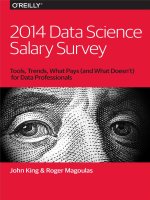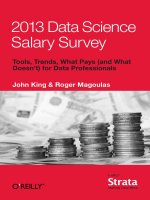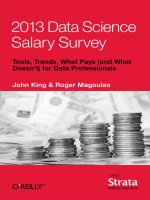IT training 2016 data science salary survey khotailieu
Bạn đang xem bản rút gọn của tài liệu. Xem và tải ngay bản đầy đủ của tài liệu tại đây (11.23 MB, 51 trang )
2016 Data Science Salary Survey
Tools, Trends, What Pays (and What Doesn’t) for Data Professionals
John King & Roger Magoulas
Participate in the
2017 Survey
The survey is now open for the 2017 report. Spend just 5 to 10
minutes and take the anonymous salary survey, here: https://
www.oreilly.com/ideas/take-the-2017-data-science-salary-survey.
Thank you!
San Jose
London
Beijing
New York
Make Data Work
strataconf.com
Presented by O’Reilly and Cloudera, Strata + Hadoop World
helps you put big data, cutting-edge data science, and new
business fundamentals to work.
■
Learn new business applications of data technologies
■
Develop new skills through trainings and in-depth tutorials
■
Singapore
Connect with an international community of thousands
who work with data
Job # D2044
2016 Data Science
Salary Survey
Tools, Trends, What Pays (and What Doesn’t)
for Data Professionals
John King & Roger Magoulas
2016 DATA SCIENCE SALARY SURVEY
November 15, 2013: First Edition
by John King and Roger Magoulas
November 13, 2014: Second Edition
The authors gratefully acknowledge the contribution of Owen S.
Robbins and Benchmark Research Technologies, Inc., who conducted the original 2012/2013 Data Science Salary Survey referenced
in the article.
September 2, 2015: Third Edition
Editor: Shannon Cutt
Designer: Ron Bilodeau, Ellie Volckhausen
Production Editor: Colleen Cole
2016-08-29: First Release
Copyright © 2016 O’Reilly Media, Inc. All rights reserved.
Printed in Canada.
Published by O’Reilly Media, Inc., 1005 Gravenstein Highway North,
Sebastopol, CA 95472.
O’Reilly books may be purchased for educational, business, or sales
promotional use. Online editions are also available for most titles
(). For more information, contact our
corporate/institutional sales department: 800-998-9938
or
August 29, 2016: Fourth Edition
REVISION HISTORY FOR THE FOURTH EDITION
While the publisher and the authors have used good faith efforts to
ensure that the information and instructions contained in this work
are accurate, the publisher and the authors disclaim all responsibility
for errors or omissions, including without limitation responsibility for
damages resulting from the use of or reliance on this work. Use of the
information and instructions contained in this work is at your own risk.
If any code samples or other technology this work contains or describes
is subject to open source licenses or the intellectual property rights of
others, it is your responsibility to ensure that your use thereof complies
with such licenses and/or rights.
2016 DATA SCIENCE SALARY SURVEY
Table of Contents
2016 Data Science Salary Survey. . . . . . . . . . . . . . . . . . . . . . 1
Executive Summary. . . . . . . . . . . . . . . . . . . . . . . . . . . . . . . . 1
Introduction. . . . . . . . . . . . . . . . . . . . . . . . . . . . . . . . . . . . 2
Factors that Influence Salary: The Regression Model. . . . . . . . . . . . 5
How You Spend Your Time. . . . . . . . . . . . . . . . . . . . . . . . . . 16
The Impact of Tool Choice. . . . . . . . . . . . . . . . . . . . . . . . . . . 22
The Relationship Between Tools and Tasks: Clustering Respondents.. 31
Wrapping Up: What to Consider Next. . . . . . . . . . . . . . . . . . . . 37
Appendix A: Full Cluster Profiles. . . . . . . . . . . . . . . . . . . . . . . 38
Appendix B: The Regression Model. . . . . . . . . . . . . . . . . . . . . 42
V
2016 DATA SCIENCE SALARY SURVEY
OVER 900
RESPONDENTS
FROM A VARIETY
OF INDUSTRIES
COMPLETED
THE SURVEY
THE RESEARCH IS BASED ON DATA collected through
an online 64-question survey, including demographic
information, time spent on specific data-related tasks,
and the use/non-use of a broad range of software tools.
2016 DATA SCIENCE SALARY SURVEY
Executive Summary
IN THIS FOURTH EDITION of the O’Reilly Data Science
Salary Survey, we’ve analyzed input from 983 respondents
working in the data space, across a variety of industries—
representing 45 countries and 45 US states. Through the
results of our 64-question survey, we’ve explored which tools
data scientists, analysts, and engineers use, which tasks they
engage in, and of course—how much they make.
Key findings include:
• Python and Spark are among the tools that contribute
most to salary.
• Among those who code, the highest earners are the ones
who code the most.
• SQL, Excel, R and Python are the most commonly used
tools.
• Those who attend more meetings, earn more.
• Women make less than men, for doing the same thing.
• Country and US state GDP serves as a decent proxy for
geographic salary variation (not as a direct estimate, but
as an additional input for a model).
• The most salient division between tool and tasks usage
is between those who mostly use Excel, SQL, and a small
number of closed source tools—and those who use more
open source tools and spend more time coding.
• R is used across this division: even people who don’t code
much or use many open source tools, use R.
• A secondary division emerges among the coding half—
separating a younger, Python-heavy data scientist/analyst
group, from a more experienced data scientist/engineer
cohort that tends to use a high number of tools and earns
the highest salaries.
To see our complete model and input your own metrics to
predict salary, see Appendix B (but beware—there’s a transformation involved: don’t forget to square the result!).
1
2016 DATA SCIENCE SALARY SURVEY
Introduction
FOR THE FOURTH YEAR RUNNING, we at O’Reilly Media
have collected survey data from data scientists, engineers, and
others in the data space, about their skills, tools, and salary.
Across our four years of data, many key trends are more or less
constant: median salaries, top tools, and correlations among
tool usage. For this year’s analysis, we collected responses from
September 2015 to June 2016, from 983 data professionals.
In this report, we provide some different approaches to the
analysis, in particular conducting clustering on the respondents (not just tools). We have also adjusted the linear model
for improved accuracy, using a square root transform and
publicly available data on geographical variation in economies.
The survey itself also included new questions, most notably
about specific data-related tasks and any change in salary.
Salary: The Big Picture
The median base salary of the entire sample was $87K. This
figure is slightly lower than in previous years (last year it
was $91K), but this discrepancy is fully attributable to shifts
in demographics: this year’s sample had a higher share of
2
non-US respondents and respondents aged 30 or younger.
Three-fifths of the sample came from the US, and these
respondents had a median salary of $106K.
Understanding Interquartile Range
For a number of survey questions, we show graphs of answer
shares and the median salaries of respondents who gave
particular answers. While median salary is probably the best
number to compare how much two groups of people make, it
doesn’t say anything about the spread or variation of salaries.
In addition to median, we also show the interquartile range
(IQR)—two numbers that delineate salaries of the middle
50%. This range is not a confidence interval, nor is it based
on standard deviations.
As an example, the IQR for US respondents was $80K to
$138K, meaning one quarter of US respondents had salaries
lower than $80K and one quarter had salaries higher than
$138K. Perhaps more illustrative of the value of the IQR is
comparing the US Northeast and Midwest: the Northeast has
a higher median salary ($105K vs. $98K) but the third quartile
BASE SALARY
Share of Respondents
0K
20K
40K
Base Salary
(US DOLLARS)
60K
80K
100K
120K
140K
160K
180K
200K
>200K
0
5%
10%
Share of respondents
15%
2016 DATA SCIENCE SALARY SURVEY
cutoffs are $133K for the Northeast and $138K for the Midwest. This indicates that there is generally more variation in
Midwest salaries, and that among top earners—salaries might
YEARS OF EXPERIENCE (in your field)
be even higher in the Midwest than in the Northeast.
SHARE OF RESPONDENTS
How Salaries Change
42%
< 5 YEARS
in places with stronger economies, wages are less likely to
stagnate.
Assessing Your Salary
To use the model for you own salary, refer to the full model in
Appendix B,
and add
up the
that apply to you.
IQR (US DOLLARS)
ANDcoefficients
MEDIAN
SALARY
Once all of the constants
are added, square the result for a
<5
final salary estimate
(note: the coefficients are not in dollars).
5 to 8
9
to
12
The contribution of a particular coefficient to the eventual
13 to 16
salary estimate depends
on the other coefficients: the higher
17 to 20
the salary, the higher the contribution of each coefficient.
Years
We also collected data on salary change over the last three
22%
years. About half of the sample reported a 20%
and
5 - 8 change,
YEARS
the salary of 12% of the sample doubled. We attempted
12%to
9 -12 YEARS
model salary change with other variables from the survey,
but the model performed much more poorly, with an R2 10%
> 20
13 - 16 YEARS
of just 0.221. Many of the same significant features in the
For
example,
the
salary
sci0 difference
50K between
100K a junior
150K data
200K
3%
salary regression model also appeared as factors in predicted 17 - 20entist
YEARS and a senior architect will be
Range/Median
greater in a country with
salary change: Spark/Unix, high meeting hours, high coding
2%salaries than somewhere with lower salaries.
high
> 20 YEARS
hours, and building
prototype models, all
PERCENTAGE CHANGE IN SALARY OVER LAST THREE YEARS
predict higher salary
SHARE OF RESPONDENTS
growth, while using
11%
6%
Excel, gender dispar+0% TO +10%
+100% TO +200%
ity, and working at
7% (TRIPLE)
13%
14%
an older company
+75% TO +100%
+10% TO +20%
NO CHANGE
(DOUBLE)
predict lower salary
6%
9%
OVER TRIPLE
growth. Geogra+50%
TO
+75%
5%
8%
NEGATIVE CHANGE
+20% TO +30%
phy also correlated
8%
positively with salary
+40%
TO +50%
8%
5%
change, meaning that
+30% TO +40%
NA (SALARY WAS ZERO)
4
2016 DATA SCIENCE SALARY SURVEY
Factors that Influence Salary:
The Regression Model
WE HAVE INCLUDED OUR FULL regression model in
Appendix B. For this year’s report, we have made two
important changes to the basic, parsimonious linear model we
presented in the 2015 report. We have included: 1) external
geographic data (GDP by US state and country), and 2) a
square root transformation. The transformation adds one step
to the linear model: we add up model coefficients, and then
square the result. Both of these changes significantly improve
the accuracy in salary estimates.
Our model explains about three-quarters of the variance in
the sample salaries (with an R2 of 0.747). Roughly half of the
salary variance is due to geography and experience. Given the
important factors that can not be captured in the survey—
for example, we don’t measure competence or evaluate the
quality of respondents’ work output—it’s not surprising that a
large amount of variance is left unexplained.
Impact of Geography
Geography has a huge impact on salary, but is not adequately
captured due to sample size. For example, if a country is repre-
sented by only one or two respondents, this isn’t enough to justify giving the country its own coefficient. For this reason, we use
broad regional coefficients (e.g., “Asia” or “Eastern Europe”),
keeping in mind however that economic differences within a
region are huge, and thus the accuracy of the model suffers.
To get around this problem, we’ve used publicly available
records of per capita GDP of countries and US states. While
GDP itself doesn’t translate to salary, it can serve a proxy
function for geographic salary variation. Note that we use
per capita GDP on the state and country level; therefore the
model is likely to produce an inaccurate estimate with GDP
figures for smaller geographic units.
Two exceptions were made to the GDP data before incorporating it into the model. The per capita GDP of Washington DC
is $181K—much greater than in neighboring Virginia ($57K)
and Maryland ($60K). Many (if not most) data science jobs in
Maryland and Virginia are actually in the greater DC metropolitan area, and the survey data suggest that average data science
salaries in these three places are not radically different from
each other. Using the true $181K figure would produce gross
5
WORLD REGION
SHARE OF RESPONDENTS
3%
8%
CANADA
UK/IRELAND
61%
15%
EUROPE (EXCEPT UK/I)
8%
UNITED STATES
ASIA
1%
AFRICA
2%
LATIN AMERICA
2%
AUSTRALIA/NZ
SALARY MEDIAN AND IQRC (US DOLLARS)
United States
Europe (except UK/I)
Region
Asia
UK/Ireland
Canada
Australia/NZ
Latin America
Africa
0K
50K
100K
150K
Range/Median
*The interquartile range (IQR ) is the middle 50% of respondents' salaries. One quarter of respondents have a salary below this range, one quarter have a salary above this range.
US REGION
SHARE OF RESPONDENTS
8%
20%
PACIFIC NW
NORTHEAST
13%
16%
22%
CALIFORNIA
MID-ATLANTIC
MIDWEST
5%
10%
SW/MOUNTAIN
SOUTH
6%
TEXAS
SALARY MEDIAN AND IQR (US DOLLARS)
California
Northeast
Region
Midwest
Mid-Atlantic
South
Pacific NW
Texas
SW/Mountain
0
50K
100K
Range/Median
150K
200K
2016 DATA SCIENCE SALARY SURVEY
Considering Gender
There is a difference of $10K between the median salaries of
men and women. Keeping all other variables constant—same
roles, same skills—women make less than men.
Age, Experience, and Industry
Experience and age are two important variables that influence
salary. The coefficient for experience (+3.8) translates to an
increase of $2K–$2.5K on average, per year of experience. As
for age, the biggest jump is between people in their early and
late 20s, but the difference between those aged 31–65 and
those over 65 is also significant.
8
Finally, in terms of work-life balance, our results show that
once you are working beyond 60 hours, salary estimates
actually go down.
GENDER
SHARE OF RESPONDENTS
Female
Male
0
20
40
60
80
SALARY MEDIAN AND IQR (US DOLLARS)
Female
Male
30K
Gender
The other exception is California. In all of the salary surveys we
have conducted, California has had the highest median salary
of any state or country, even though its per capita GDP ($62K)
is not ranked so high (nine states have higher per capita GDPs,
as do two countries that were represented in the sample,
Switzerland and Norway). The anomaly is likely due to the San
Francisco Bay Area, where, depending on how the region is
defined, per capita GDP is $80K–$90K. As a major tech center,
the Bay Area is likely overrepresented in the sample, meaning
that the geographic factor attributable to California should be
pushed upward; an appropriate compromise was $70K.
We also asked respondents to rate their bargaining skills on
a scale of 1 to 5, and those who gave higher self-evaluations tended to have higher salaries. The difference in salary
between two data scientists, one with a bargaining skill “1”
and the other with “5”, with otherwise identical demographics and skills, is expected to be $10K–$15K.
Gender
overestimates for DC salaries, and so the per capita GDP figure
for DC was replaced with that of Maryland, $60K.
60K
90K
Range/Median
120K
150K
AGE
7%
1%
OVER 60
51 - 60
16%
41 - 50
39%
31 - 40
SALARY MEDIAN AND IQR (US DOLLARS)
UNDER 31
31 - 40
Age
38%
under 31
41 - 50
51 - 60
SHARE OF RESPONDENTS
over 60
0
50K
100K
Range/Median
150K
200K
YEARS OF EXPERIENCE (in your field)
SHARE OF RESPONDENTS
42%
SALARY MEDIAN AND IQR (US DOLLARS)
< 5 YEARS
22%
<5
12%
Years
5 to 8
5 - 8 YEARS
9 to 12
13 to 16
9 -12 YEARS
10%
17 to 20
> 20
13 - 16 YEARS
3%
0
50K
17 - 20 YEARS
100K
150K
200K
Range/Median
2%
> 20 YEARS
PERCENTAGE CHANGE IN SALARY OVER LAST THREE YEARS
SELF-ASSESSED BARGAINING SKILLS (1 Being Poor, 5 Being Excellent)
SHARE OF RESPONDENTS
Poor - 1
11%
6%
2
18%
14%
NO CHANGE
35%
3
5%
NEGATIVE CHANGE
31%
4
5%
SALARY MEDIAN AND IQR (US DOLLARS)
+0% TO +10%
Excellent - 5
NA (SALARY WAS ZERO)
9%
7%
(Poor) 1
13%
+10% TO +20%
8%
2
3
9%
4
+100% TO +200%
(TRIPLE)
+75% TO +100%
(DOUBLE)
0
+30% TO +40%
8%
50K
100K
+40% TO +50%
Range/Median
6%
OVER TRIPLE
+50% TO +75%
+20%(Excellent)
TO +30% 5
8%
6%
Skill Level
SHARE OF RESPONDENTS
150K
200K
OPERATING SYSTEMS (Respondents could choose more than one OS)
EASE OF FINDING A NEW ROLE
SHARE OF RESPONDENTS
LINUX
23%
3
42%
MAC OS X
Windows
SALARY MEDIAN AND IQR (US DOLLARS)
Linux
(Very difficult) 1
Mac OS X
2
Unix
3
iOS (as a developer)
4
Android (as a developer)
(Very easy) 5
36%
4
18%
UNIX
2%
Very easy - 5
IOS (as a developer)
28%
0
30K
30K
60K
60K
OS
74%
Very difficultWINDOWS
-1
2%
2
9%
49%
90K
120K
150K
90K
120K
Range/Median
Range/Median
Ease of Finding Work
SALARY MEDIAN AND IQR (US DOLLARS)
SHARE OF RESPONDENTS
150K
2%
ANDROID (as a developer)
COMPANY AGE
SHARE OF RESPONDENTS
4%
SALARY MEDIAN AND IQR (US DOLLARS)
< 2 YEARS
14%
Campany Age
< 2 years
2 - 5 years
2 - 5 YEARS
14%
6 - 10 years
11 - 20 years
6 - 10 YEARS
18%
> 20 years
11 - 20 YEARS
51%
> 20 YEARS
0
30K
60K
90K
Range/Median
120K
150K
COMPANY SIZE
15%
8%
2,501 - 10,000
EMPLOYEES
1,001 - 2,500
EMPLOYEES
7%
28%
501 - 1,000
EMPLOYEES
10,000+
EMPLOYEES
19%
101 - 500
EMPLOYEES
SALARY MEDIAN AND IQR (US DOLLARS)
14%
26 - 100
EMPLOYEES
1
2 - 25
Company Size
26 - 100
101 - 500
8%
2 - 25 EMPLOYEES
501 - 1,000
1,001 - 2,500
2,501 - 10,000
1%
1 EMPLOYEE
SHARE OF RESPONDENTS
10,000 or more
0
30K
60K
90K
Range/Median
120K
150K
3%
LENGTH OF WORK WEEK
3%
5%
60+ HOURS/WEEK
56 - 60 HOURS/WEEK
51 - 55 HOURS/WEEK
16%
46 - 50 HOURS/WEEK
25%
41 - 45 HOURS/WEEK
SALARY MEDIAN AND IQR (US DOLLARS)
< 30 hours
30 to 35
40 HOURS/WEEK
36 to 39
Length of Work Week
30%
40 hours
41 to 45
9%
46 to 50
36 - 39 HOURS/WEEK
3%
30 - 35 HOURS/WEEK
2%
> 30 HOURS/WEEK
SHARE OF RESPONDENTS
51 to 55
56 to 60
> 60 hours
0
50K
100K
Range/Median
150K
200K
5%
INDUSTRY
SHARE OF RESPONDENTS
6%
7%
HEALTHCARE /
MEDICAL
6%
ADVERTISING /
MARKETING / PR
8%
GOVERNMENT
3%
EDUCATION
INSURANCE
3%
MANUFACTURING (NON-IT)
BANKING / FINANCE
3%
PUBLISHING / MEDIA
8%
RETAIL / E-COMMERCE
3%
CARRIERS / TELECOMMUNICATIONS
11%
2%
OTHER
COMPUTERS / HARDWARE
2%
14%
SEARCH / SOCIAL NETWORKING
SOFTWARE
(INCL. SAAS, WEB, MOBILE)
2%
CLOUD SERVICES / HOSTING / CDN
15%
CONSULTING
1%
NONPROFIT / TRADE ASSOCIATION
1%
SECURITY (COMPUTER / SOFTWARE)
SALARY MEDIAN AND IQR (US DOLLARS)
Consulting
Software (incl. SaaS, Web, Mobile)
Retail / E-Commerce
Banking / Finance
Healthcare / Medical
Advertising / Marketing / PR
Industry
Education
Government
Insurance
Manufacturing (non-IT)
Publishing / Media
Carriers / Telecommunications
Computers / Hardware
Search / Social Networking
Cloud Services / Hosting / CDN
Nonprofit / Trade Association
Security (Computer / Software)
Other
0
30K
60K
90K
Range/Median
120K
150K
2016 DATA SCIENCE SALARY SURVEY
How You Spend Your Time
Importance of Tasks
Relevance of Job Titles
The type of work respondents do was captured through four
different types of questions:
When both tasks and job titles are included in the training
set, job title “wins” as a better predictor of salary. It’s notable
however, that titles themselves are not necessarily accurate
at describing what people do. For example, even among
architects there was only a 70% rate of major engagement
in planning large software projects—a task that theoretically
defines the role. Since job title does perform well as a salary
predictor, despite this inconsistency, it may be that “architect,”
for example, is a symbol of seniority as much as anything else.
• involvement in specific tasks
• job title
• time spent in meetings
• time spent coding
For every task, respondents chose from three options: no
engagement, minor engagement, or major engagement.
The task with the greatest impact on salary (i.e., the greatest
coefficient) was developing prototype models. Respondents
who indicated major engagement with this task received
on average a $7.4K boost, based on our model. Even minor
engagement in developing prototype models had a +4.4
coefficient.
16
Respondents with “upper management” titles—mostly C-level
executives at smaller companies, directors and VPs—had a
huge coefficient of +20.2. Engagement in tasks associated
with managerial roles also had a positive impact on salary,
namely: organizing team projects (+9.7), identifying business
problems to be solved with analytics (+1.5/+6.7), and communicating with people outside the company (+5.4).
JOB TITLE
3%
3%
4%
PRINCIPAL / LEAD
3%
RESEARCHER
ARCHITECT
CONSULTANT
2%
8%
SENIOR ENGINEER / DEVELOPER
MANAGER
11%
OTHER
SALARY MEDIAN AND IQR (US DOLLARS)
9%
ENGINEER/
DEVELOPER/
PROGRAMMER
Data Scientist
Upper Management
Engineer / Developer / Programmer
11%
Job Title
Other
Manager
UPPER MANAGEMENT
Consultant
Researcher
Principal / Lead
Architect
Senior Engineer / Developer
45%
DATA SCIENTIST
SHARE OF RESPONDENTS
0
50K
100K
Range/Median
150K
200K









